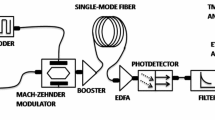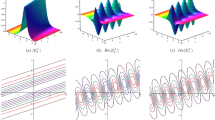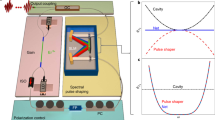Abstract
Under the condition of the higher order effects, a propagation equation is established to investigate the way to suppress the soliton self frequency shift and timing jitter in the picosecond and femtosecond soliton communication system using a combined control method of time domain and frequency domain. By the use of the variational approach, the evolution of the chirping Gaussian quasi-soliton pulse is analyzed in the presence of the effects including third order dispersion, intrapulse Raman scattering (IRS), and self steepening. Considering the soliton evolution properties and the mechanism of the timing jitter under the higher-order effects, the combined control method is adopted to eliminate the influence from Raman scattering and self-steepening. The soliton central frequency is stabilized and the timing jitter is suppressed effectively. A 160 Gb/s long-haul soliton transmission system is designed and its performance is numerically simulated. The simulation results are in good agreement with our theoretical analysis.
Similar content being viewed by others
References
Ganapathy R, Porsezian K, Hasegawa A. Soliton interaction under soliton dispersion management. IEEE J Quantum Electr, 2008, 44: 383–388
Zhu B, Yang X. Fiber soliton-form 3R regenerator and its performance analysis. Sci China Ser F-Inf Sci, 2007, 50: 241–250
Wen Y, Chen M, Yang X. Influence of pulse frequency shifting on soliton transmission system. Chinese Sci Bull, 1995, 40: 734–738
Yang X, Zhao Y. Raman self-pumped generation in soliton propagation and its influence on siliton transmission. Acta Phys Sin, 1989, 38: 745–752
Yang X, Wen Y. Fundamental Theories of Optical Fiber Soliton Communications (in Chinese). Beijing: National Defence Industry Press, 2000
Agrawal G. Nonlinear Fiber Optics. San Diego, CA: Academic, 2001
Kato M, Mori Y. Determination of actual interaction length for self-frequency shift of raman solitons and their independence of pump intensities. IEEE Photon Tech Lett, 2006, 18: 1386–1388
Wang Y, Wang W. Study of ultrafast pulse coupling dynamics considering retarded nonlinear response and self-steepening effects. J Lightwave Technol, 2006, 24: 1041–1046
Santhanam J, Agrawal G. Raman-induced timing jitter in dispersion-managed optical communication systems. IEEE J Select Topics Quant Electr, 2002, 8: 632–639
Poutrina E, Agrawal G. Effect of distributed Raman amplification on timing jitter in dispersion-managed lightwave systems. IEEE Photon Technol Lett, 2002, 14: 39–40
Sofia C, Latas V, Mário F F. Soliton propagation in the presence of intrapulse Raman scattering and nonlinear gain. Opt Commun, 2005, 15: 415–422
He Y, Wang H. Phase jitter control of ultrashort solitons by use of Butterworth filters and nonlinear gain. Opt Fiber Tech, 2007, 13: 67–71
Yang R, Li L, Hao R, et al. Combined solitary wave solutions for the inhomogeneous higher-order nonlinear Schrödinger equation. Phys Rev E, 2005, 71: 6616–6620
Baboiu D, Mihalache D, Panoiu N. Combined influence of amplifier noise and intrapulse Raman scattering on the bit-rate limit of optical fiber communication systems. Opt Lett, 1995, 20: 1865–1867
Santhanam J, McKinstrie C, Lakoba T, et al. Effects of precompensation and post-compensation on timing jitter in dispersion-managed systems. Opt Lett, 2001, 26: 1131–1133
McKinstrie C, Santhanam J, Agrawal G. Gordon-Haus timing jitter in dispersion-managed systems with lumped amplification: analytical approach. J Opt Soc Amer B, 2002, 19: 1211–1218
Porsezian K, Hasegawa A, Serkin V, et al. Dispersion and nonlinear management for femtosecond optical solitons. Phys Lett A, 2007, 361: 504–508
Author information
Authors and Affiliations
Corresponding author
Rights and permissions
About this article
Cite this article
Zhu, B., Yang, X. The influence of higher-order effects on the transmission performances of the ultra-short soliton pulses and its suppression method. Sci. China Ser. F-Inf. Sci. 53, 182–190 (2010). https://doi.org/10.1007/s11432-010-0021-0
Received:
Accepted:
Published:
Issue Date:
DOI: https://doi.org/10.1007/s11432-010-0021-0




